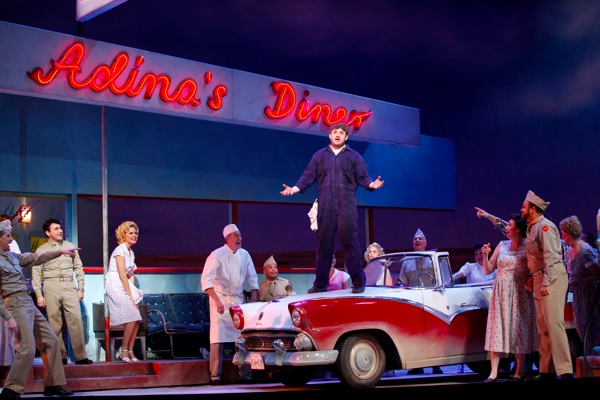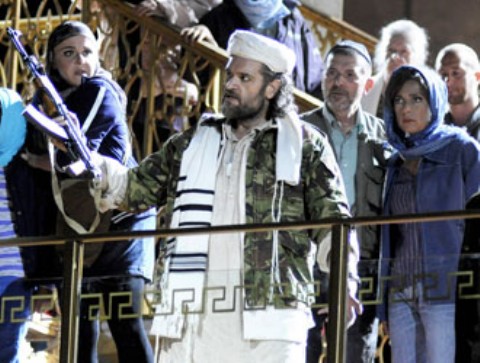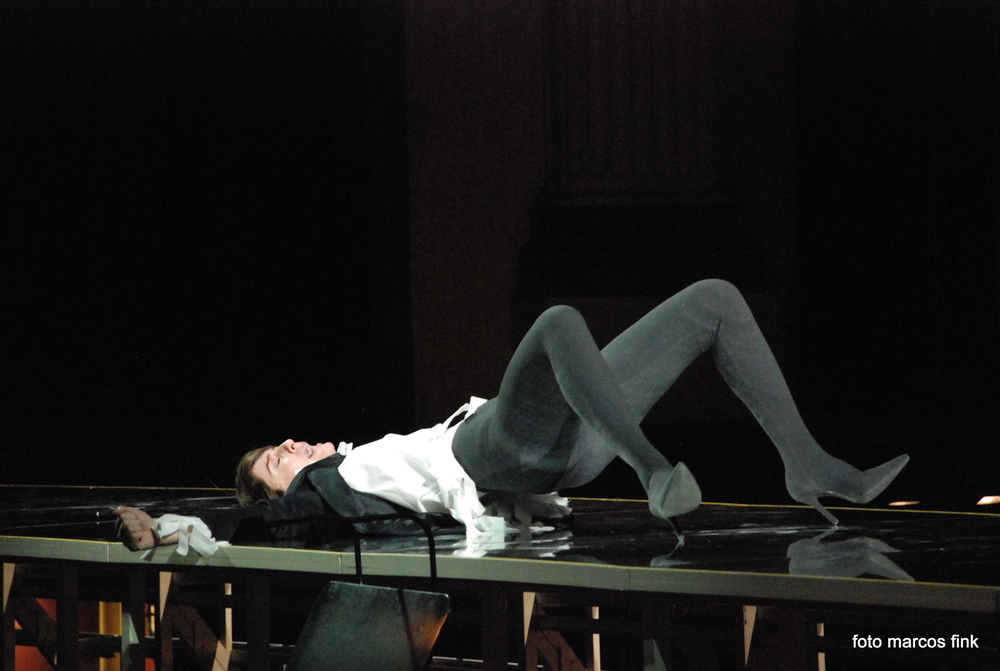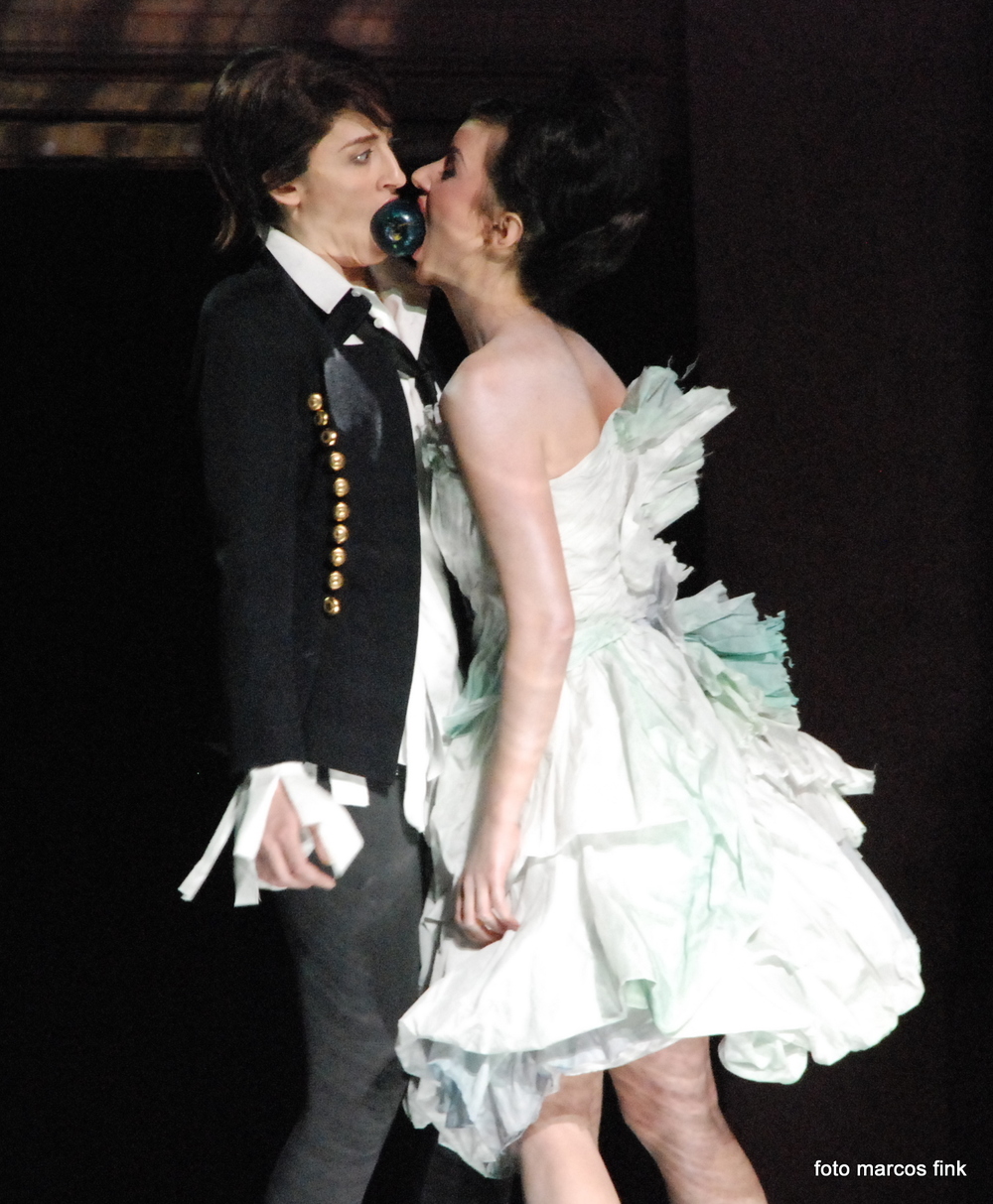A woman stands backstage wearing a pair of skin tight leggings stretched over a pair of 4 inch stilettos and pulled up to her waist. The look is topped with a shredded men's shirt and a military style bolero jacket, all of which have been designed by the fashion icon Christian Lacroix. She enters the performance area by mounting a set of steep mirrored stairs, and has a very heated, sexually charged exchange involving another woman and an apple that is painted blue, which they hold in their mouths as they slowly dance around one another in a circle. The other woman exits and the woman in the tight pants proceeds to lie down on the floor and stick her crotch in the air, which by the way, I forgot to mention, is covered in a big sparkly codpiece.
Which high cultural art form was this a description of?
Well, what if I would have told you that the stairs being ascended were leading to a platform that extended into the theater of the Berlin Staatsoper, in front of an orchestra pit full of players from the Akademie für Alte Musik and the conductor René Jacobs, and that while said woman was lying on the floor with her crotch thrust in the air, she was simultaneously singing an aria? And also, p.s., that the woman was me? Well then you might have guessed "An Opera," on your first try -but that wouldn't have been nearly as mysterious. Plus, then you would have answered my next question for the Spring for Music Blogger Challenge right away (yup - I made it to round two), without allowing me a couple of paragraphs to convince you first.
I feel kind of bad, because the initial question they asked was about the cultural capital of the U.S., which I said was New York City, where I happen to live. And now they're asking the following question:
We live in an aggressively visual age; images dominate the popular culture. But which art form has the most to say about contemporary culture, and why?
And I feel like I've been asked another question that I am particularly qualified to answer becuase the answer just happens to be my own profession. Maybe I'm biased, but they say if you wanna write, you should write what you know, so sue me, I'm standing by my answers.
I think there are two ways to look at this question - the first would be which art form has been the most affected by contemporary culture, and the second would be which art form is the most likely to be used as a platform to comment on contemporary culture. And my answer to both those questions is still: Opera. Go figure.
First of all, the way Opera as an art form has developed in the 20th and 21st century tells us a lot about this culture in which the image has become such a dominating factor. People in the opera world often point out that this seems to be the era of the director - as compared the previous eras, where impresarios and conductors ruled the roost. Also, beauty of person is coming dangerously close to knocking out beauty of voice for the most important factor in making an opera singer famous. In Europe especially, productions that are visually stunning (or often, shocking) are the norm, and most reviews that you read of operas both here and in Europe go into much more detail about the production itself than the level of music making. Directors often expect singers to do things that never would have been asked of them even 30 years ago, and singers, who are so frequently these days slim and athletic, usually comply. The infamous "Little Black Dress" scandal, where Deborah Voigt, one of the leading Strauss singers of her generation, was fired from a production of Ariadne auf Naxos because she didn't fit into the director's ideal of how she should look in the costume, was an example of how things are changing. Voigt then went on to have weight loss surgery, and the now slim soprano is taking on roles like Salome - a role she probably wouldn't have considered at her previous weight.
Singing opera is really hard. The demands of training this instrument like you would a violin - but one that happens to be inside your throat, combined with learning to amplify your voice so that it can naturally carrry to as many as 4,000 people, and doing so with sure footed technique, taste, and style, and often in a foreign language is in and of itself pretty major. But in today's market, all that stuff I just mentioned is not enough - you should also be really, really pretty. The other day I was watching a video of Joan Sutherland and Marilyn Horne singing the famous duet from Norma. I'm not sure any two singers will ever sing that duet with more precision, beauty, and such an unbelieveable symbiosis, and it got me thinking about the two most famous singers that might be cast in those roles in a production today. I thought immediately of Netrebko and Garanca, two women who definitely have gorgeous voices, but who are also wrapped up in gorgeous packages. Don't get me wrong, Horne and Sutherland were both gorgeous too, but our standards of beauty have changed so much, I fear that if Marilyn Horne auditioned to sing Adalgisa today for a production at the Met that was going to be broadcast into HD movie theaters, somebody would say she didn't have the right "body type" for the role, and they would tell dame Joan that she was "too tall - and we're also not sure how that jaw of yours will read in a close up."
Of course, focusing on the visual aspect of this amazing art form isn't necessarily a bad thing. The production I was describing in the beginning of this post was Handel's Agrippina that I was lucky enough to be a part of in 2010 in Berlin. I say lucky becuase this was an example of all the elements of opera coming together for a production that highlights the visual beauty, the drama, and the music equally. The conductor was very exacting musically, and the director respected that the drama was IN the music, not IN SPITE OF the music, so we got to have our proverbial cake and eat it too. Plus I got to wear clothes designed specifically for me by Christian Lacroix. I mean, come on - in what universe can that be anything but amazing?
But as for my second reading of the question, that wonders which art form is the most effectively able to comment on our contemporary culture within the frame of the art form itself, I again have to answer that it's opera. Because opera combines all the elements of art - visual art, music, drama, and dance (maybe movement would be more accurate - but my crotch aria that I talked about before felt pretty dance-y to me, frankly), it is very alluring to directors as a platform for creativity. Not only does it combine all the above elements, but it also allows them to comment on questions that have been posed literally for centuries, but in a modern context. Both Peter Sellars and Jonathan Miller have set Italian operas (Cosi Fan Tutte and L'Elisir D'Amore, respectively) in an American Diner. Or more controversially, the director Graham Vick's recent settings of La Clemenza di Tito in the 30's, with Tito as a fascist, and Rossini's Moses in Egypt in contemporary times, where Moses was dressed like Bin Laden and the Jews were terrorists gassing the Egyptians. The list of opera productions that both push the limits and challenge (and often enrage or at least annoy) the audience goes on and on. What other art form not only allows, but encourages those kinds of provacative additions to pieces of art that have already been in existence for hundreds of years?

 Because of its visual aspect, Opera has the unique ability to move forward with our culture of images, but still present a historical document musically of what has been around for centuries. So I don't think we should automatically poo-poo the current trend towards productions and beauty having their place in our world. I just think we should find the balance between all the elements, and I know it's possible because I've been part of productions that did just that. In fact, I like to think that my sparkly cod-piece and I are helping to keep opera relevant, one baroque thrust at a time.
Because of its visual aspect, Opera has the unique ability to move forward with our culture of images, but still present a historical document musically of what has been around for centuries. So I don't think we should automatically poo-poo the current trend towards productions and beauty having their place in our world. I just think we should find the balance between all the elements, and I know it's possible because I've been part of productions that did just that. In fact, I like to think that my sparkly cod-piece and I are helping to keep opera relevant, one baroque thrust at a time.

Just so you know I wasn't exaggerating in my first paragraph: Pictured: Me and Anna Prohaska, Berlin State Opera, 2010. Photo courtesy of Marcos Fink.
(there was one photo with the cod piece, but frankly I found it a little R rated for this highly reputable bunch of bloggers. Look it up on youtube if you want to be shocked)
Don't forget to vote for me if you want to. Click this link beginning on Monday and ending Thursday, and look for Trying to Remain Operational in the right hand column and click vote.
